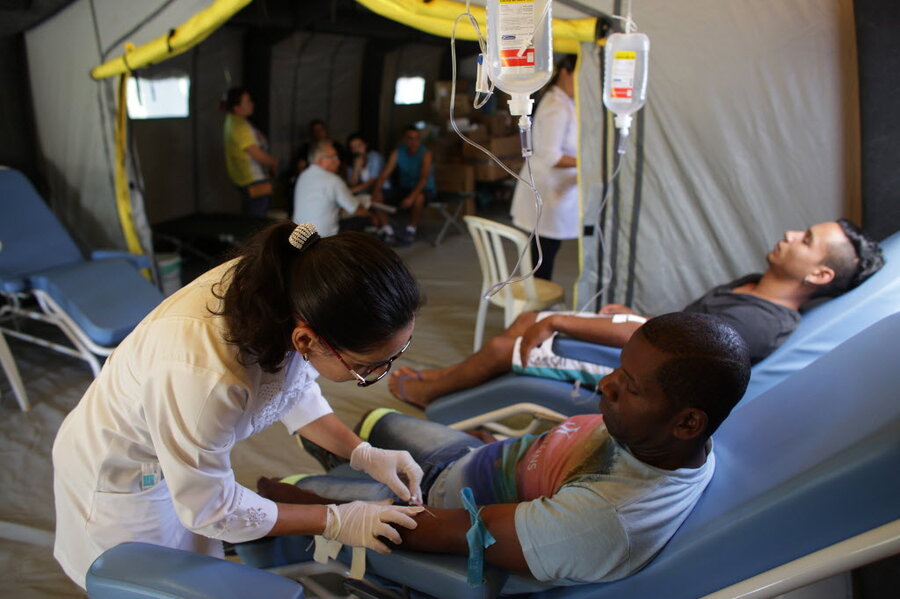Zika Virus: the world's newest global health emergency
Loading...
| Mexico City
The World Health Organization this month declared the mosquito-borne virus Zika a global health emergency, saying it could possibly reach 4 million people by the end of 2016. The virus was first detected in Uganda more than fifty years ago, but the suspected links to birth defects in Brazil and neurological disorders across the region have Latin American governments on alert, launching mosquito-eradication campaigns, investigating potential vaccines, and kickstarting studies to try and determine concretely if and how Zika plays into the rise in microcephaly and Guillain-Barré.
Q: How does Zika fit the pattern of other global health crises?
In 2005, the World Health Organization (WHO) introduced a new system of identifying and declaring global health emergencies, and Zika is one of four viruses to rise to this level of concern. It joins the ranks of H1N1 (swine flu) in 2009; Ebola, which tore through West Africa in 2014; and outbreaks of polio in Pakistan and Syria in 2014.
Zika’s addition to this list took many experts by surprise: There have been outbreaks in Africa and Asia over the past several decades with little international attention, in part because the symptoms often go undetected.
“The confusing part of declaring Zika a global health emergency is that the last [declaration] was Ebola, which had a high likelihood of death” and spurred elevated levels of fear, says Christian Lindmeier, a WHO spokesman. “This is completely different. It’s not transmitting in the same way and there’s nowhere close to the same complications.”
What earned Zika a spot on the WHO’s list are its possible links to microcephaly, a condition in which babies are born with severe disabilities, and Guillain-Barré syndrome, a neurological disorder that can cause paralysis. Though the WHO label can trigger panic, the intention is to spur action. Already researchers from around the globe are coming together to study, monitor, and search for solutions to Zika.
Q: What do we know about Zika in the Americas so far?
Zika was identified in Brazil last May, and has since spread to more than 20 countries in the Americas. It’s transmitted through the Aedes aegypti mosquito, which also carries diseases like dengue and chikungunya. The spread is “explosive,” according to the WHO, in part because it is new in the region and the population hasn’t built up a resistance. Governments are encouraging citizens to clean up stagnant water, wear long-sleeved clothing, and use bug repellent. Some have suggested women put off getting pregnant.
“[W]e have no prior experience of Zika in this current form, and so have no expectations,” says Derek Gatherer, a virus researcher at Lancaster University in England. New discoveries – and theories – are emerging each week, from the possible transmission of Zika through bodily fluids to a group of doctors in Brazil and Argentina controversially questioning whether microcephaly could be linked to chemicals used to treat water for mosquito larva.
Out of the more than 5,000 suspected cases of microcephaly reported in Brazil since October, 462 cases have been confirmed and another 765 have been dismissed. Some 41 cases have been officially linked to Zika. No cases of Zika-tied microcephaly have emerged in other affected Latin American countries so far, but public health officials continue to monitor the situation.
Q: Could this change the conversation around women’s access to birth control and abortion in Latin America?
When nations including El Salvador, Ecuador, Brazil, Colombia, and Jamaica warned women to put off getting pregnant until more was known about Zika, the realities of reproductive rights in the region came under the spotlight. Latin America is home to some of the most restrictive abortion laws in the world, the majority of pregnancies are unplanned, and access to contraceptives and robust sex education is severely limited. In El Salvador, for example, abortion is illegal under all circumstances including rape and a risk to the mother’s life.
The advice to delay pregnancy in light of the possibility of children being born with serious birth defects linked to Zika “ignores the reality that many women and girls simply cannot exercise control over whether or when or under what circumstances they become pregnant,” the UN High Commissioner for Human Rights said this month.
Although some officials, judges, and media outlets in the region have raised the possibility that abortion laws could – or should – be revised, the discussion has created a backlash in the world’s most Roman Catholic region. However, Pope Francis made international headlines when he suggested that contraceptives could possibly be used to prevent the spread of the Zika virus, despite that the church condemns birth control.
Q: Will this affect the Olympics?
The Summer Olympics in Rio de Janeiro kick off Aug. 5, and although the Brazilian government says Zika will not pose a problem, some countries and athletes are on guard. But Brazilian President Dilma Rousseff is certain the Games will go on. “We are confident that by the time the Olympics begin we will have considerable success in exterminating the mosquito [that’s spreading Zika],” she said.
Mosquito populations are highest during the summer, which is currently under way in the Southern Hemisphere. Although mosquitoes bite year-round in Brazil, come August and September when the Olympics and Paralympics take place, temperatures will be slightly cooler and rainfall less frequent, meaning fewer mosquitoes.








